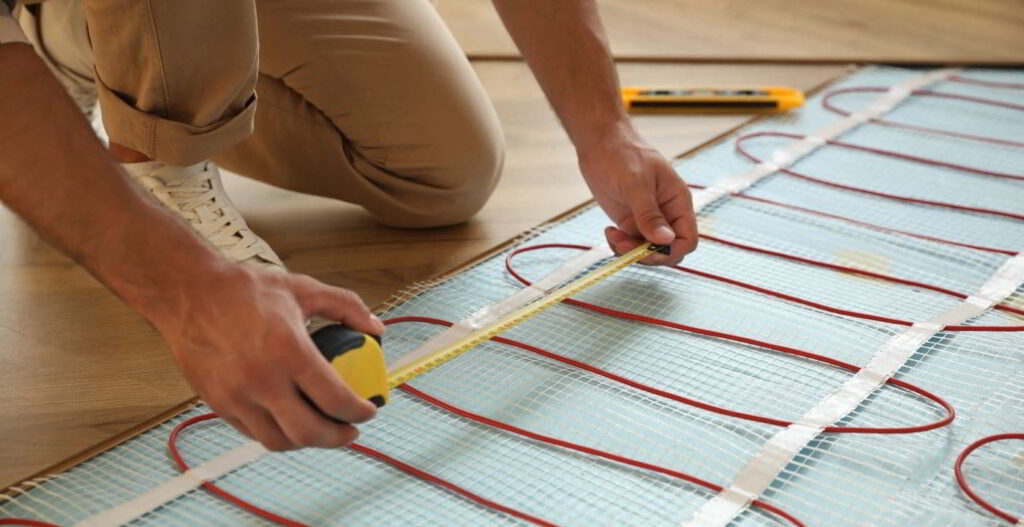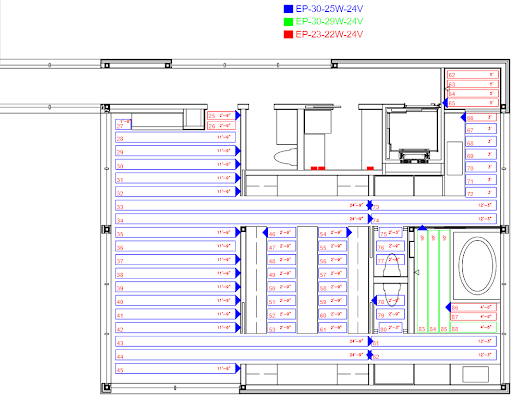Key Takeaways
- Before you begin to design your radiant floor heating you must determine its primary function: is it a primary heating system, a complimentary heating system, or just for floor warming?
- A well-designed system prioritizes floor type, heating element spacing, and room layout to ensure uniform heating.
- For optimal efficiency and safety, choosing suitable heating elements for your floor type and matching the power supply, controller, and wire gauge to your needs is key.
Determine Your Heating Needs

Before diving into the specifics of your radiant heating system design, it’s essential to decide on the application of the floor heating system.
This decision will significantly influence your design and calculations.
Here are some factors you should consider to ensure a perfect in floor heating design:
Primary Heat, Complementary Heat, or Floor Warming
This will determine how much heat you’ll need from the floor.
Will it be the primary source of heat in your room, or will it supplement other heating sources?
Alternatively, is it just to provide a comfortable temperature for your feet?
Outdoor Temperature & Insulation
Consider the average outside temperature, the insulation values of your house, and the size of the room.
All these will influence how much heating your floor needs to provide.
Special Considerations for Additions & Conservatories (for “special spaces/ different than normal ie garage” and sunrooms)
These areas may have different heating requirements based on usage and construction, so treat them separately.
Keep your Budget in Mind
If you are working within a fairly strict budget make sure you don’t go overboard in the design stage. How much your radiant floor heating will cost is largely determined by what you do in the design phase of the project.
Design and Calculation

Primary Heat
This will determine how much heat you’ll need from the floor.
Will it be the primary source of heat in your room, or will it supplement other heating sources?
Alternatively, is it just to provide a comfortable temperature for your feet? (Very repetitive)
Heat Loss Calculation
Determine the wattage needed to heat your space to the required temperature.
This will factor in the type of construction, insulation values, and room measurements.
Fortunately, some providers offer services for specific heat loss calculations.
Element Spacing
Based on the necessary wattage, design the spacing between the heating elements.
You might need to opt for an element with a higher wattage or adjust the distance between them.
Complementary Heat
If the floor heating is used as a complementary heat source, ensure it provides even heating without competing with the main heating system’s thermostat.
Using an external floor temperature sensor is advised in this scenario.
Floor Warming
Floor warming systems aim to remove the cold feeling from floors but are not the primary heat source.
Consider the following:
Needs Assessment
Determine the requirements for each area, considering room type, open floor space, and floor covering.
Bathrooms
They may require more heat. Achieve this by selecting heating elements with higher wattage or placing elements in walls, under tubs, or behind mirrors.
Architectural Support
At Green Wave Distribution, we collaborate closely with architects, crafting tailored heating and electrical solutions.
Leveraging our proprietary AutoCAD design software and skilled system specialists, we ensure that our heating or snow melting system designs and wiring diagrams align perfectly with your architectural blueprints.
For projects with an emphasis on sustainability, we offer product guidance, usage projections, and thermal loss assessments.
This equips both you and your clients with the essential data and insights needed for well-informed choices.
Layout and Design

Recommended Spacing
Electric Radiant Flooring
Ceramic Tile & Stone: 2-3 inches (5-7.5 cm)
Hardwood & Laminate: 2-5 inches (5-13 cm)
Carpet: 2-8 inches (5-20 cm)
If heating needs are below 3.5 W/sq. ft. (38 W/m2), ensure that the spacing between element strips doesn’t create cold spots.
Hydronic Radiant Flooring
1/2″ Diameter Tubing: 8-12 inches (20.32-30.48cm)
5/8″ Diameter Tubing: 8-14 inches (20.32-35.56cm)
7/8″ Diameter Tubing: 12-16 (30.48cm-40.64)
A hydronic floor heat design will be very similar to an electric system but ensuring the correct spacing of the element strips is paramount to the success of both systems.
Power Supply and Controller

Ensure the power supply and controller are correctly matched to your heating system’s needs.
The design wattage per circuit, the maximum element length, and the distribution for each circuit in the power supply are all crucial.
Controllers like the EPI-DC-M3 come with three channels of 500 watts, designed for a 90% capacity or 450 watts for each channel.
Wire Gauge and Circuitry
To ensure optimum performance and safety, plan wire runs as short as possible and use an appropriate wire gauge for the required power output.
Design Examples
A radiant heat system design involves careful planning. This will include taking exact measurements of each room into which you want to install radiant floor heating.
Once the measurements and dimensions are in place a design blueprint will be created (usually using CAD or other architectural software) to determine the floor plan, amount of materials required, electrical and wiring connections and technical specifications including Heated Area, Design Output, Design Load and Watts/Sq-Ft.
Below we have included some radiant floor designs to give you an idea of the kind of planning you need to install radiant floor heating.
First Floor (Primary Heat, embedded into the slab)

Bathroom

Kitchen (Pre-assembled Kitchen “Roll and Go”)

Basement

Bedroom

FAQs
How can I ensure that the floor temperature remains safe for occupants?
For health and safety reasons, it’s essential to ensure that the floor surface temperature does not exceed 85ºF (29ºC). STEP Heat’s indoor radiant heating elements are engineered to never exceed 84 degrees.
Using an external sensor is recommended, especially for systems intended for floor warming, to maintain the appropriate floor temperature and prevent overheating.
What considerations should I keep in mind when installing heating elements under different types of floor coverings?
The spacing between heating element strips varies depending on the type of floor covering.
For instance, with ceramic tiles or natural stone, the spacing should be between 2-3 inches (5-7.5 cm), while for carpets, it can be between 2-8 inches (5-20 cm).
Make sure to place element strips perpendicular to hardwood and engineered floors to ensure even heating.
How do I optimize power usage for my radiant floor heating system?
To optimize energy efficiency, it’s crucial to choose the heating element that corresponds with your heating needs and available floor space.
Additionally, your system’s wattage should align with the design wattage of your power supply (e.g., 90%, or 450 watts for a 500W circuit).
Conclusion
Radiant floor heating offers a blend of comfort and efficiency that few other heating methods can match.
The success of any radiant heating system depends on meticulous planning taking into account factors like outside temperatures, room size, insulation, and the type of flooring used to name just a few.
When designing radiant floor heating It’s imperative to prioritize safety and efficiency, ensuring floor temperatures remain within recommended limits and that the system operates with energy-conscious guidelines.
To ensure the best results it is always best to benefit from the experience of professional radiant floor engineers. Start designing your own personalized radiant floor heating system today with Green Wave Distribution.





